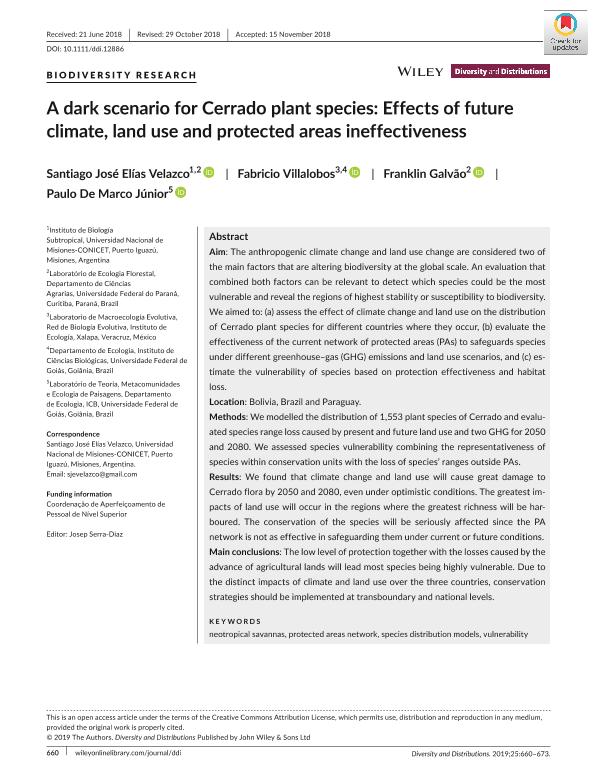Mostrar el registro sencillo del ítem
dc.contributor.author
Velazco, Santiago José Elías

dc.contributor.author
Villalobos, Fabricio
dc.contributor.author
Galvao, Franklin

dc.contributor.author
de Marco Junior, Paulo

dc.date.available
2020-05-07T20:46:09Z
dc.date.issued
2019-01
dc.identifier.citation
Velazco, Santiago José Elías; Villalobos, Fabricio; Galvao, Franklin; de Marco Junior, Paulo; A dark scenario for Cerrado plant species: effects of future climate, land-use, and protected areas ineffectiveness; Wiley Blackwell Publishing, Inc; Diversity and Distributions; 25; 4; 1-2019; 660-673
dc.identifier.issn
1366-9516
dc.identifier.uri
http://hdl.handle.net/11336/104565
dc.description.abstract
Aim: The anthropogenic climate change and land-use change are considered two of the main factors that are altering biodiversity at the global scale. An evaluation that combined both factors can be relevant to detect which species could be the most vulnerable and reveal the regions of highest stability or susceptibility to biodiversity.We aimed to (i) assess the effect of the climate change and land-use on the distribution of the Cerrado plant species for different countries where it occurs, (ii) evaluate the efficiency of the current protected areas (PAs) network to safeguards species under different greenhouse gas (GHG) emissions and land-use and (iii) estimate the vulnerability of species caused by protection efficiency and habitat loss.Location: Bolivia, Brazil, and ParaguayMethods: We modeled the distribution of 1,553 plant species of Cerrado and evaluated species range loss caused by present and future land-use and two GHG for 2050 and 2080. We assessed the species vulnerability combining the representativeness of a species´ distribution within conservation units and the loss of species range outside PAs.Results: We found that climate change and land-use will cause great damage to Cerrado flora by 2050 and 2080, even under optimistic conditions. Unfortunately, the greatest intensity and extent of land-use will have to overcome on the regions where the greatest richness will be harbored. The conservation of the species will be seriously affected since the PAs network is not as efficient in safeguarding them under current or future conditions. Main conclusions: The low level of protection together with the losses caused by the advance of the agricultural frontier will lead to most species being highly vulnerable. Due to the climate and land-use, effects showed different interactions in each country, conservation strategies should be implemented at transboundary and national levels.
dc.format
application/pdf
dc.language.iso
eng
dc.publisher
Wiley Blackwell Publishing, Inc

dc.rights
info:eu-repo/semantics/openAccess
dc.rights.uri
https://creativecommons.org/licenses/by/2.5/ar/
dc.subject
NEOTROPICAL SAVANNAS
dc.subject
PROTECTED AREAS NETWORK
dc.subject
SPECIES DISTRIBUTION MODELS
dc.subject
VULNERABILITY
dc.subject.classification
Conservación de la Biodiversidad

dc.subject.classification
Ciencias Biológicas

dc.subject.classification
CIENCIAS NATURALES Y EXACTAS

dc.title
A dark scenario for Cerrado plant species: effects of future climate, land-use, and protected areas ineffectiveness
dc.type
info:eu-repo/semantics/article
dc.type
info:ar-repo/semantics/artículo
dc.type
info:eu-repo/semantics/publishedVersion
dc.date.updated
2020-05-04T15:22:45Z
dc.journal.volume
25
dc.journal.number
4
dc.journal.pagination
660-673
dc.journal.pais
Reino Unido

dc.journal.ciudad
Londres
dc.description.fil
Fil: Velazco, Santiago José Elías. Consejo Nacional de Investigaciones Científicas y Técnicas. Centro Científico Tecnológico Conicet - Nordeste. Instituto de Biología Subtropical. Instituto de Biología Subtropical - Nodo Puerto Iguazú | Universidad Nacional de Misiones. Instituto de Biología Subtropical. Instituto de Biología Subtropical - Nodo Puerto Iguazú; Argentina. Universidade Federal do Paraná; Brasil
dc.description.fil
Fil: Villalobos, Fabricio. Instituto de Ecología; México. Universidade Federal de Goiás; Brasil
dc.description.fil
Fil: Galvao, Franklin. Universidade Federal do Paraná; Brasil
dc.description.fil
Fil: de Marco Junior, Paulo. Universidade Federal de Goiás; Brasil
dc.journal.title
Diversity and Distributions

dc.relation.alternativeid
info:eu-repo/semantics/altIdentifier/doi/http://dx.doi.org/10.1111/ddi.12886
dc.relation.alternativeid
info:eu-repo/semantics/altIdentifier/url/https://onlinelibrary.wiley.com/doi/full/10.1111/ddi.12886
Archivos asociados
